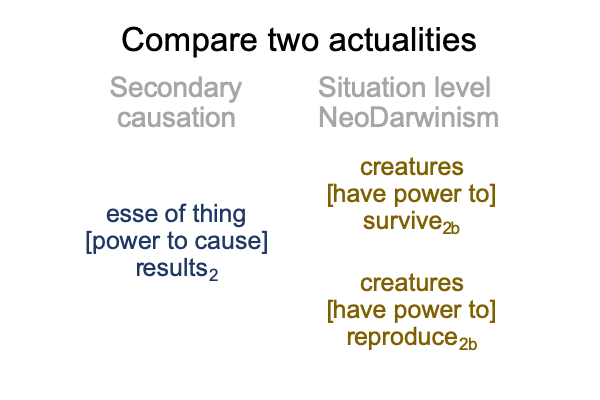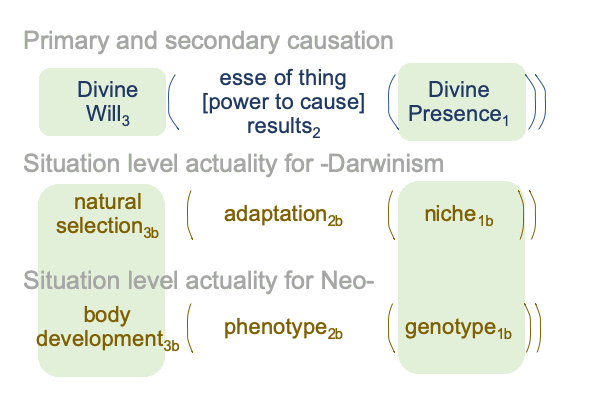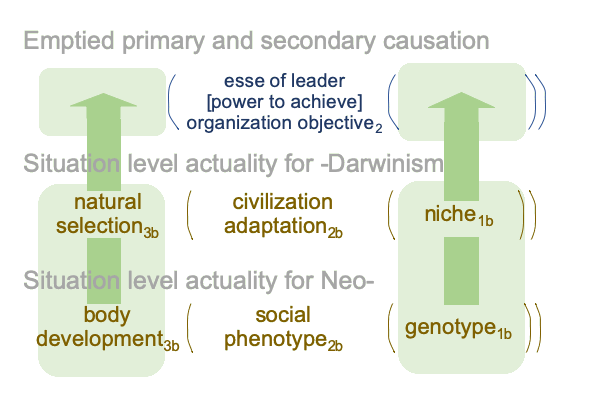Comments on Armand Maurer’s Essay (2004) “Darwin, Thomists and Secondary Causality” (Part 4)
Section Four, Maritain
0055 Jacques Maritain (7682-7773 U0’) pops thought bubbles. Sometimes, he succeeds. Sometimes, he does not.
In 7773, he takes a jab at a bubble that still pervades the modern Zeitgeist. Natural selection3b and body development3bexclude the Divine Will3.
Maritain pens an essay. The title is “Towards a Thomistic Idea of Evolution”. The word, “towards”, conveys the tentative character of his argument. He aims to take secondary causality to the… um… next level.
0056 Maritain points out that living beings embody immanent and self-perpetuating activities. Such activities give living beings an active role in evolution. This point reflects a general principle. God gives, to created beings, the dignity of secondary causation, under the guidance of primary causality.
Maritain draws a distinction about the living being’s powers of immanent activity.
0057 First, these powers reside in each individual of a species, even though they govern and perpetuate the entire species.
To me, this sounds like a fusion of the eternal now and the evolutionary eon, allowing a comparison between secondary causality2 and adaptation2b.
0058 Second, living beings have a self-regulating power that is subtle. It does not appear on the surface. This power appears to work against entropy. Matter may acquire higher form under the elevating action of God.
To me, this sounds like a fusion of secondary causality2 with the dynamics underlying the phenotype2b.
0059 Does Maritain draw on Mivart’s intuition that evolution requires an external and an internal account?
Not really, Maritain and Mivart do not contradict one another. Secondary causality2 compares to adaptation2b and phenotype2b, formulated as dyads.
Here is how that looks.

0060 Maritain ascribes primary causality to God, but not to the exclusion of the secondary agency of created beings.
The two normal contexts3b for NeoDarwinism complements or aligns with the theological normal context3 for primary and secondary causes.
Also, the potentials1 are inclusive, with a very curious twist. God’s Divine Presence sustains the actuality of ‘something’ independent of the adapting species2a, the environment of evolutionary adaptation, as well as the DNA2a. God has plenty of room to tinker with biological evolution.
0061 Here is a picture of the comparison.

0062 According to Thomas Aquinas, matter has a potential, or an appetite, for forms of ascending perfection. “Perfection” does not mean “without flaws”. Rather, “perfection” suggests “completion”. Matter and form associate to actuality2. Perfection adds the normal context3 and the potential1.
Is this key to a philosophical understanding of biological evolution?
Maritain spells out the ascending levels, composite bodies, mixed bodies, vegetative bodies and souls, sensitive or animal bodies and souls, and intellectual or human bodies and souls. Matter ascends from content to situation to perspective, on the wings of its own secondary causes, in the normal context of the Divine Will3 and in the possibilities inherent in the Divine Presence1.
0063 Certainly, this is not the only way to construct a hierarchy of nested forms. But, it is surely a good one.
Maritain keeps his eyes on the writings of Thomas Aquinas.
0064 Yet, even before his death at a ripe old age, a young, Peirce-enamored Thomist, John Deely (7747-7817 U0’), presents him with a thesis. Later, Deely writes about an interplay between Peirce and Aquinas. Deely discovers that Peirce arrives at the same definition of sign as the Baroque Scholastic, John Poinsot (7389-7444 U0’).
What does this imply?
C. S. Peirce may be regarded as the first in a postmodern neoscholastic tradition.
Peircean formulations, such as the category-based nested form, belong in the scholastic tradition.

